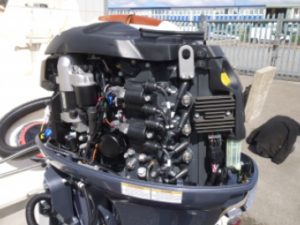 If your boat is not equipped with an engine, you can usually take two options. You can grab the oars and paddle away to catch your big fish. That has a certain charm to it, actually, and it’s not truly a non-option. But still, it’s often inconvenient, and for many people, that doesn’t sound very inspiring at all. I like paddling, but many people are not fans of working the oar unless it’s for fitness or they absolutely have to. That leaves only one option of the two: an outboard engine. That doesn’t mean the choice pool is short of other options. You can also abandon the very idea of fishing on the water, but you probably understand why I’m not offering that.
If your boat is not equipped with an engine, you can usually take two options. You can grab the oars and paddle away to catch your big fish. That has a certain charm to it, actually, and it’s not truly a non-option. But still, it’s often inconvenient, and for many people, that doesn’t sound very inspiring at all. I like paddling, but many people are not fans of working the oar unless it’s for fitness or they absolutely have to. That leaves only one option of the two: an outboard engine. That doesn’t mean the choice pool is short of other options. You can also abandon the very idea of fishing on the water, but you probably understand why I’m not offering that.
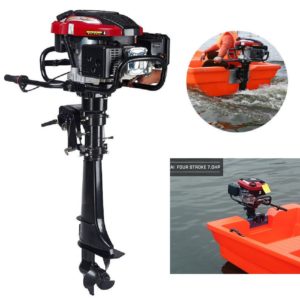
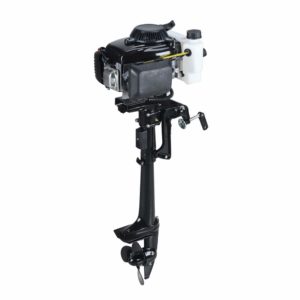
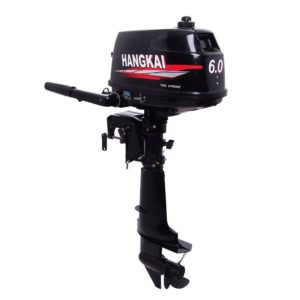
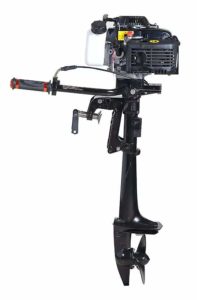
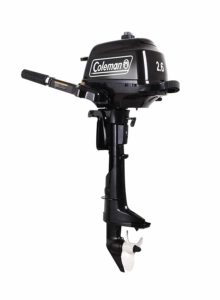
Top 5 Best Outboard Motors in 2019
1Feiuruhf Outboard Motor — Best Low-Emission Motor
If you want a low-power low emission overboard motor that you can actually afford, consider this 4-stroke motor. It is suitable both for saltwater and freshwater. That’s hardly a huge advantage. Instead, that’s something you have every right to expect from any motor you buy, but it’s better to know that your pick can do what you expected it to do anyway, rather than be rudely awaken.
The motor has a 50-cm shaft. That translates to almost 20 inches, which puts this motor in the long shaft motors group. I wouldn’t advise it for an inflatable boot although it’s usable with one. Instead, I recommend reserving it for monohull boats with a noticeable draft.
The motor delivers 7HP, which may seem insufficient to those who have little experience with boats but rest assured, it’s definitely enough. More so since the engine has a torque between 4500 and 5500 RPM. With the transmission ratio a little higher than 2, the maximum torque of the propeller would only be half that number.
And those were just the basic specs. Still, this Hangkai motor sold as Feiuruhf Outboard Motor can boost more than only those. It is a stunning motor, one that is also highly resistant to corrosion and other harmful factors. Like any 4-stroke motor, it is environmentally friendly and highly efficient.
That said, fueling it with anything other than 92-octane gasoline is hardly a good idea. The tank holds up to 1.4L of fuel, which is enough for most purposes. Also, it’s a high-maintenance motor.
- 7HP
- Torque between 4500 and 5500 RPM
- Transmission ratio a little higher than 2
- Stunning motor
- Highly resistant to corrosion and other harmful factors
- Environmentally friendly and highly efficient
- A poor fit for an inflatable boat
- High-maintenance motor
2SEA DOG WATER SPORTS 4 Stroke Outboard MotorSEA DOG WATER SPORTS 4 Stroke Outboard Motor — Most Efficient MotorMost Efficient Motor
If fuel efficiency is of particular importance to you, then this SEA DOG motor is just the product for you. It’s only marginally better than other 4-stroke engines, but every single detail of this motor has been designed to allow for better efficiency. This SEA DOG outboard motor is equipped with the latest fuel-saving solutions. The combustion chamber alone provides for better fuel efficiency. Combined with the other methods, this motor steps into the realm of clarktech. OK, I’m exaggerating, but you got the idea.
At two HP and a half, it’s a pretty low-power motor, which is hardly a disadvantage. It’s low-profile makes it ideal for small boats and blow-up boats especially. The shaft is long enough, but it’s still mountable on low-profile boats.
It doesn’t matter what your boat’s factor is (please refer to Buyers’ Guide for further instruction), this motor is not powerful enough to overwhelm it.
At the same time, I do not recommend installing this motor on boats that weigh well above 100 pounds. You can use this motor on them if you wish, but the lighter the boat, the better results you can expect.
The motor is super-lightweight, and you can carry it wherever you go. It is suitable for both freshwater and saltwater, just as you would expect.
- Equipped with the latest fuel-saving solutions
- Super-lightweight, and you can carry it wherever you go
- Ideal for small boats and blow-up boats especially
- Not for boats that weigh well above 100 pounds
3BSTOOL 6HP 2 Stroke Outboard Motor — Best 2-Stroke Motor
This is a 2-stroke motor, which puts it firmly in the lightweight category. It is made for boats no heavier than 100 kg.
But it’s a 2-stroke motor, and that in itself is a considerable disadvantage. I would never recommend it to anyone who isn’t already looking for a 2-stroke carburated motor. Are you that person? Fine, then you will find everything you hoped to gain in this Hangkai motor (BSTOOL sells them but doesn’t make them). For those concerned with efficiency, a 4-stroke or a DFI 2-stroke is much better.
It has every disadvantage of a 2-stroke motor I can think of: it is loud, high-emission, inefficient, and possibly soon to be banned in the whole world. You also have to mix oil with fuel, which is unneeded for 4-stroke engines. So, why would I put it on the list of best outboard motors? Because, as far as 2-strokes go, it really is the best motor out there. It’s capable of giving you 6 HP, which translates to 5000-6000 RPM, and it’s going to make your boat quite a fast one.
Still, if you don’t know if you want a 2-stroke carburetor motor, it would be better to buy something else entirely.
- Lightweight
- As far as 2-strokes go, it really is the best motor out there
- 5000-6000 RPM
- 6 HP
- Loud
- 2-stroke motor
- High-emission
- Inefficient
4Leadallway Four Stroke Air-Cooled Outboard Motor — Best Overall
It’s a medium-power outboard motor designed for fuel efficiency and ease of control. It is very compact and has a low net weight. That makes it exceptionally easy to carry and makes it possible to install on even the lightest of inflatable boats.
At 4HP, it is capable of speeding up to 12 knots with a load of 4 people, provided the boat itself is feather-light. The torque is 5000-6000 RPM, and the shaft is relatively short, but, again, that is ideal for inflatable boats.
All in all, this is one of the best picks for any inflatable boat, considering its performance and sheer efficiency.
- Designed for fuel efficiency and ease of control
- Compact
- Low net weight
- Possible to install on even the lightest of inflatable boats
- 5000-6000 RPM
- Capable of speeding up to 12 knots with a load of 4 people
- Short shaft
5Coleman Powersports — Best Bang for the Buck
A good and efficient motor which I have no right to call reliable. Unfortunately, it may stall all too easy. Why does that happen? The manufacturer claims that this motor is unsuitable for using of high altitudes. By that, I mean altitudes above 2,500 feet. To use the engine at higher altitudes, you would have to install a high-altitude jet, but even then the motor won’t run at 8,000 feet, for instance, although it will work at only 5,000 feet.
Is it any good for the sea level? Yep, but if you plan on using it on rivers and lakes, you better know how high they are located.
If you ignore the high-altitude problem, then the Coleman Powersports is a pretty adequate 4-stroke motor. I only recommend it for lighter watercraft, and even then, you have to mind the altitude.
- Good and efficient motor
- Pretty adequate 4-stroke motor
- May stall at higher altitudes
- For higher altitudes, you would have to install a high-altitude jet, but even then the motor won't run at 8,000 feet and higher
Buyer’s Guide
2-stroke vs. 4-stroke
Each has its advantages, but I’ll have you know it’s only a matter of time 2-stroke engines are outlawed globally. They aren’t that good in the first place, and they pose a significant danger to the environment as a whole and marine life in particular.They are often cheaper and have long been the first low-power option to consider, but things have changed now. Nowadays, it’s more economical and more efficient to go electric. On top of those perks, it is also safer for the environment. So if you find that all of the options are too overpowered compared to your needs, go and get an electric trolling motor. You won’t regret it. They are more or less silent, but at the same time, they can manage blow-up boats just fine.That said, electric motors are only so powerful. They are also less reliable, or, to be more precise, people trust them less, sometimes for good reasons. Conventional engines are better for high speed, and if they run out of fuel, you can refill them, provided you brought some extra fuel with you. Something like that is more challenging to accomplish when you’re dealing with batteries.But that’s beside the point.Do I recommend 4-stroke over 2-stroke? Absolutely! I can’t stress it enough: 4-stroke engines are just more powerful and more economical, unlike 2-stroke engines. Not that such a disadvantage can’t be worked around. Some of the outboard motor manufacturers equip their a-stroke engines with direct fuel injection, that does neutralize the typical problems, but it does make the price higher. Are they better than conventional 2-stroke motors? Yes, they are. So, if you are sure that you are a 2-stroke person, feel free to so for that option.Fuel Consumption
The power, the torque, the weight are all critical. However, if your outboard motor consumes too much fuel per mile, there won’t be an honest person crazy enough to call it “the best outboard motor.” It doesn’t matter how fast your boot moves if it’s dead weight after covering ten miles.That is where traditional 2-stroke outboard motors fail to shine. Calling them economical is laughable. They are flawed on the conceptual level. That said, it only concerns the conventional systems. Direct fuel injection systems are free from that flaw, even 2-stroke motors.Start Type
The way you start an engine does not speak of its efficiency and performance. Still, ergonomics make things more convenient. All in all, I recommend an electric start over pull start, but it’s not something that you should consider among the most important things. If you have two options that are virtually the same, but one of the motors is to be hand started, and the other comes with electric start, I would definitely choose the latter. Even then, you should consider every factor at play. Electric start makes an engine more expensive. What’s worse, you would be dependent on having a power source to start the engine. In a way, it’s like having an electric motor, but without the advantages and with lesser power draw.Torque
It’s quite easy: the higher the torque, the better. Technically, torque is not the same as performance, but it might as well be. Still, confusing them isn’t right. Torque is what the engine is capable of. Torque affects the speed of the boat, it affects the power of the motor, but it doesn’t translate to either.To put it in layman’s terms, torque is how fast the engine spins. That’s about it. You can have 10,000 rotations per minute, but the propeller may have a lower torque. The numbers are totally made up, but they are good enough to make a point.My advice? Always pay attention to the engine’s torque, but keep in mind that the other parameters may be more important. I’m not saying they will be, yet since the possibility is there, being a little more cautious wouldn’t hurt.Your boat’s parameters and Dimensions
Since you want a motor for a boot, accounting for the boat’s features and characteristics is a must. A big enough engine can, theoretically, make the boat take on water. I’m talking about extremes, but I’m also making a point. There are other issues that have zero relation to the bot’s and engines weigh. For instance, you have to remember about vibrations some materials are pretty good at conducting them, and they cab, while vibrations tend to be something boaters tend to avoid.Your boat’s weight and size have a direct relation to the draft, while the draft, combined with the mass of the boot, is responsible for water resistance. As you can guess, the higher that number, the more powerful engine you need to install. But after you do that, its weight is going to be added to the beats own weight. And you may or may not need a more powerful engine. Little details that make a choice harder, but you still have to account for them. Thankfully, things don’t actually go exponentially complicated, but again, your choice of installed equipment, including the motor you’re trying to pick, may affect your boat’s characteristics.Boat Weight
Of all the characteristics of your boat, this one is the most important. Even a child can tell that a bigger boat needs a bigger motor. How big? Now that is a question of an adult person.The rule of thumb is 1 HP per 40 pounds at most. I don’t just mean the boat’s own weight, but also the cargo. Still thinking it’s too little? Well, I never said you would be able to speed up with that ratio. That is enough to get the boot moving, but if you want speed, you have to get a motor that can deliver 1HP per 25 pounds, or anywhere in between.At the same time, I advise that you do consider the motor’s weight. If you get one that is too powerful, it can easily tip the balance and make the boot nigh inoperable.The size of the boat
It’s nice to have found the motor that seems just right for your boat. It sucks when you find out it doesn’t really fit your boat when it comes to installation. To avoid that kind of situation, you must be aware of the outboard motor’s precise dimensions and measure your boat’s transom thoroughly.Another issue related to the size of the boat is the weight of the motor. Unfortunately, too many boaters come face to face with that issue. I can ever give you an explanation as to why that happens repeatedly. Quite a few old boats were made to be equipped with a 2-stroke engine. But with all the legal pressure and the overall decline in popularity, 2-stroke engines are now a suboptimal choice. Yet, they are absolutely lighter than 4-stroke engines, which is why they have been preferable to them for lighter boats for a long time.It’s still possible to use them together, but you have to be careful if you don’t want the speed to be affected.Shaft Length
The length of the shaft is something not many people would consider right away. Meanwhile, it is one of the more critical parameters. Suffice to say, a shaft that is too short won’t even reach the water surface, while an unnecessarily long shaft may shift the balance and lower the stern. That would make the propeller first to hit the lake bottom if it ever comes close to running aground and let us not forget that a tipped up bow and a powerful motor is not a situation you’d like to find yourself in.So, what makes a short or long shaft? If a shaft is shorter than 15 inches, it is considered short. If, on the other hand, it is longer than 20 inches, we’re dealing with a long shaft.Most of my subscribers need short shafts because most people operate lightweight boats, especially inflatable boats. Nevertheless, I recommend against taking my words for granted. First, what if I’m wrong? Second, I’ve never seen your boat. There is no way for me to know what kind of shaft it actually needs. What I can do, however, is to give you some pointers.The plate of the shaft should rest against the bottom of the hull when installed.Power
I’ve already talked about how to calculate the power of the motor. I think you feel it is entirely rational to calculate the minimum required power. But why put a cap on the engine power? Is it a situation where too good is bad? Yes, folks, and in more ways than one.To begin with, overpowering your boot is a bad idea because of legal consequences. I’m not joking, check out this link, if you have trouble believing me.You need to calculate your boat’s factor if you want to make sure the motor you have in mind won’t be too powerful for the boat. Use the following formula:F is the factor;Bl is the length of your boat;Tmax is the transom width.After you have the factor, you can work with that and look it up.| Factor | 0-35 | 36-39 | 40-42 | 43-45 | 46-52 |
| Max HP | 3 | 5 | 7.5 | 10 | 15 |
